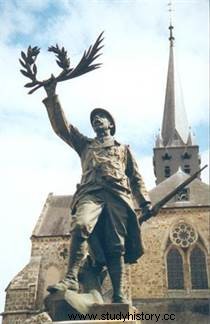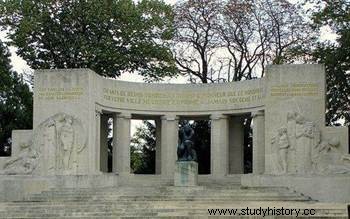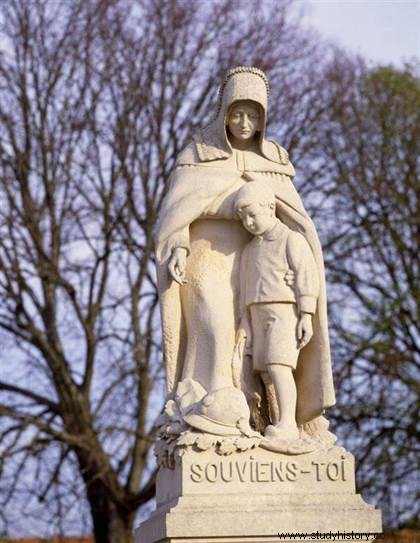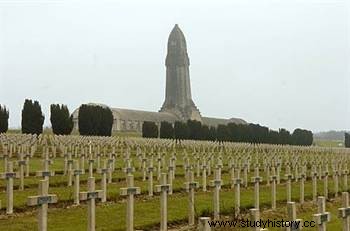 After the trauma of WWI , almost all the municipalities of France erect monuments to the dead to commemorate the memory of fallen men. There is an old misunderstanding about the true meaning of these monuments. Integrated into the Republican memory. These places of memory which welcome men adorned with decorations, tricolor flags, intoning La Marseillaise, cast doubt on the true interpretation which must be given to these monuments. Are they therefore republican monuments or nationalist monuments?
After the trauma of WWI , almost all the municipalities of France erect monuments to the dead to commemorate the memory of fallen men. There is an old misunderstanding about the true meaning of these monuments. Integrated into the Republican memory. These places of memory which welcome men adorned with decorations, tricolor flags, intoning La Marseillaise, cast doubt on the true interpretation which must be given to these monuments. Are they therefore republican monuments or nationalist monuments?
The construction of war memorials
The erection of war memorials at the end of the 1914-1918 war is not a new phenomenon. Two factors can be put forward to explain why practically all the communes of France have a monument to the dead. On the one hand, the First World War was marked by the scale of the mobilization and the number of deaths. On the other hand, its favorable outcome marked by the victory of 1918 seems to be able to explain the origin of the construction of war memorials, in contrast to the war of 1870-1871 which mobilized fewer men and whose outcome ended in defeat. During this conflict, the construction of war memorials was the fruit of private initiatives (committees, associations) and belated, twenty to thirty years after the war.
Built outside the context of war, these monuments reflect a desire for revenge that does not include other actors such as representatives of the nation, local communities or the State. Conversely, the war of 1914-1918 associates different actors, citizens, municipalities as well as the State for the construction of these monuments. By law, the State undertakes to subsidize the construction of monuments within the communes. It allows official recognition but does not impose the construction of a monument, it encourages it through financial aid.
The populations have been associated by the municipalities in the construction of war memorials. Their construction is due to municipal actions. It is the citizens from their municipalities who pay tribute to the war dead. The most common inscription on war memorials is as follows:The commune of... to his children, who died for France. A link then persists between the municipality from which the collective initiative comes, the citizens, recipients of the tribute and France, which receives their sacrifice and justifies it.
 The construction of war memorials was carried out very quickly, even before the implementation of the law of October 1919 and the election of the horizon blue room in November 1919. The monuments were built in practically all the villages of France before 1922, however, their construction proved to be more complex and longer within the towns dotted with debates and in which monuments were still erected in the early 1930s. Above all, the significance of the monuments seems to have been elaborated even before their erection through demonstrations to the war dead. This cult, born even before the armistice, was built in a context where the outcome of the war was still uncertain. Across all of these factors, is a nationalist reading a tenable hypothesis?
The construction of war memorials was carried out very quickly, even before the implementation of the law of October 1919 and the election of the horizon blue room in November 1919. The monuments were built in practically all the villages of France before 1922, however, their construction proved to be more complex and longer within the towns dotted with debates and in which monuments were still erected in the early 1930s. Above all, the significance of the monuments seems to have been elaborated even before their erection through demonstrations to the war dead. This cult, born even before the armistice, was built in a context where the outcome of the war was still uncertain. Across all of these factors, is a nationalist reading a tenable hypothesis?
Typology of war memorials
A very widespread prejudice on the left of the political spectrum tends to maintain that war memorials express nationalism through the hairy people who surmount the monuments. However, this type of representation is rare, even minority. Thus, through this type of prejudice, it appears that the decryption of war memorials is more complex and that a certain number of elements come into play in order to understand the real meaning of war memorials.
The first meaning of the monument to the dead is inscribed in space. Its location is essential in the vast majority of villages, except for a few. The choice of location is never innocent through the places of the Town Hall, the Church or a heavily frequented crossroads. The presence or absence of statuary, generally a hairy one even if there is other representation, is an important element for the interpretation of a war memorial. Whether due to its cost or for ideological reasons, this type of building is in the minority. The furry depicted realistically or idealized can influence its meaning. It can be replaced by a bare stele, an urn or a funerary torch as well as a war cross. Other representations were created, such as widows accompanied by orphans, old parents expressing the mourning of the survivors. There is a great diversity of inscriptions which are explicit and in which resonate feelings of sadness, moralizing or as a sign of homage. The names of the people inscribed on the monuments provide little information.
A whole series of monuments exist and dot the daily life of millions of people.
Civic and patriotic monuments
The civic monument consists of a bare stele, built in a space in which the town hall is located. On this monument is inscribed the names of the dead accompanied by a very often used formula, "The commune of...to its children who died for France". There is a variant, "...died for the Fatherland". This expression refers to a more national language and does not refer to a local tradition. This monument is characterized by its austerity marked by the absence of allegorical representation, apart from the war cross. It expresses the homage of the municipality and its living citizens to the citizens who died in the war. This type of monument, by its great counting does not prejudge the opinions of the citizens. Everyone is free to express their feelings. A republican and secular monument that avoids any religious distinction. This monument is located between the more patriotic one and another more funerary. Sliding to one or the other is relatively easy.
 Another type of monument, this one patriotic, is located in a public square, at a crossroads and visible of all. It has different iconography and inscriptions. The formula, "... died for the Fatherland" is very present here, accompanied by formulas borrowed from the semantic fields of honor, glory and heroism. Added to the frontal inscription, other inscriptions with patriotic connotation on the other faces of the monument. Monuments to the dead bear the verses of Victor Hugo, for example, which thus affirms its republican dimension. A patriotic monument which can swing towards nationalism through certain signs such as the Gallic rooster, the statues of the triumphant hairy man, the presence of a flag, that of a spiked helmet or a trampled imperial eagle. Symbols constitute an exacerbated nationalism with the representation of a winged victory holding a crown.
Another type of monument, this one patriotic, is located in a public square, at a crossroads and visible of all. It has different iconography and inscriptions. The formula, "... died for the Fatherland" is very present here, accompanied by formulas borrowed from the semantic fields of honor, glory and heroism. Added to the frontal inscription, other inscriptions with patriotic connotation on the other faces of the monument. Monuments to the dead bear the verses of Victor Hugo, for example, which thus affirms its republican dimension. A patriotic monument which can swing towards nationalism through certain signs such as the Gallic rooster, the statues of the triumphant hairy man, the presence of a flag, that of a spiked helmet or a trampled imperial eagle. Symbols constitute an exacerbated nationalism with the representation of a winged victory holding a crown.
Some of these elements are added to the same monument. These allegorical representations are, however, more complex. The crown does not necessarily symbolize victory, it can also represent mourning. Female figures as well. A wingless woman can symbolize a France or a Republic. The Hairy statue is not necessarily patriotic. A soldier standing guard like a sentinel exists on certain monuments. There is an idealization which constitutes the first element of patriotism. The sentry in the way it is represented can slide from republican patriotism to exacerbated nationalism depending on the pose, the look...However, other hairy people express an unequivocal patriotism through the image of a soldier on the verge of to die using the flag as a shroud. This category of representation shows that this patriotic monument is also sliding towards the funerary monument.
Funeral and pacifist monuments
The funeral monument is located near the Church or stands in the cemeteries marked by the presence of a cross. This type of monument glorifies the sacrifice of the dead and breaks with the representations mentioned above. It presents the obligation of the accomplishment of the duty by the love dedicated to the Fatherland, as to a religion. As such, it justifies the sacrifice. This monument seems to contrast with the republican spirit for which the individual is the end of society. The funerary monuments do not necessarily have a statue and contain an inscription in which the patriotic connotation is absent, "The commune of... to its dead children".
 The pacifist monument is relatively rare. The iconography is in this case precious to identify these pacifist monuments. The case of Levallois-Perret on which a worker breaks a sword, representation of the proletariat breaking the war, is evocative in this respect. The whole of this typology is directly linked to the local political sensibilities at the time when these monuments were built.
The pacifist monument is relatively rare. The iconography is in this case precious to identify these pacifist monuments. The case of Levallois-Perret on which a worker breaks a sword, representation of the proletariat breaking the war, is evocative in this respect. The whole of this typology is directly linked to the local political sensibilities at the time when these monuments were built.
The objective of war memorials is to preserve the name of each of the dead of the municipality, which demonstrates the republican spirit of these buildings, which wants citizens to be equal in right even in the face of death. Beyond material reality, history has also played a role in the interpretation of war memorials in relation to the evolution of society and certain significant events. Ceremonies performed by citizens may have given new meaning to the meanings of war memorials.
Bibliography
- Antoine PROST, “The war memorials, Republican worship? Civic worship? Patriotic worship? », Pierre NORA (dir.), Places of memory, Paris, Gallimard, 1984, pp. 195-225.
- Annette BECKER, war memorials. 1991.
